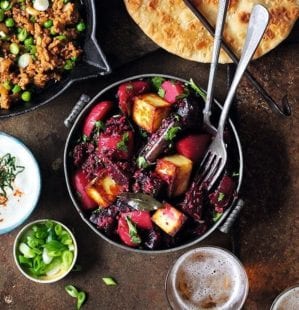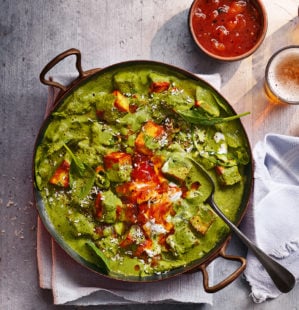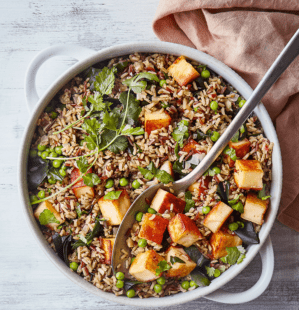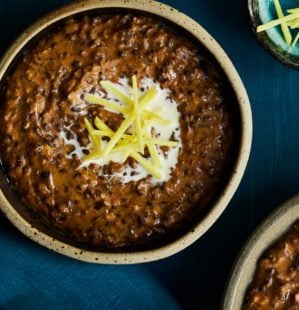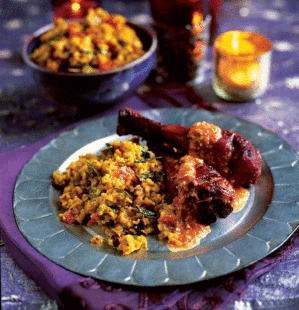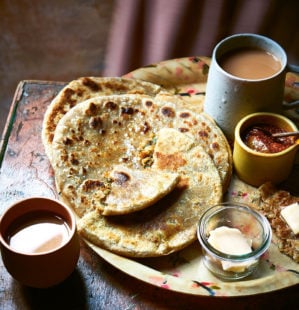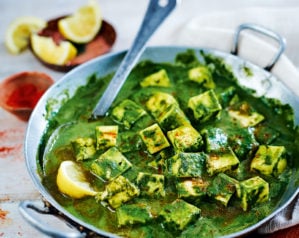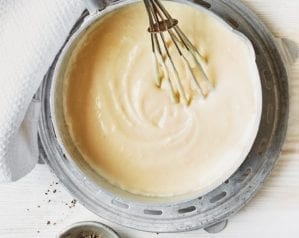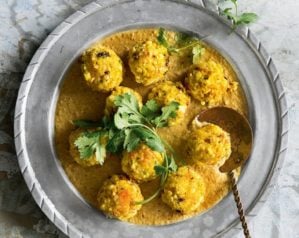
Paneer makhani
- Published: 27 Mar 24
- Updated: 27 Mar 24
Chef and owner of Michelin-starred restaurant Opheem, Aktar Islam, shares his recipe for paneer makhani. Have a go at making your own paneer before simmering in the rich, creamy sauce which is full of warming spices.
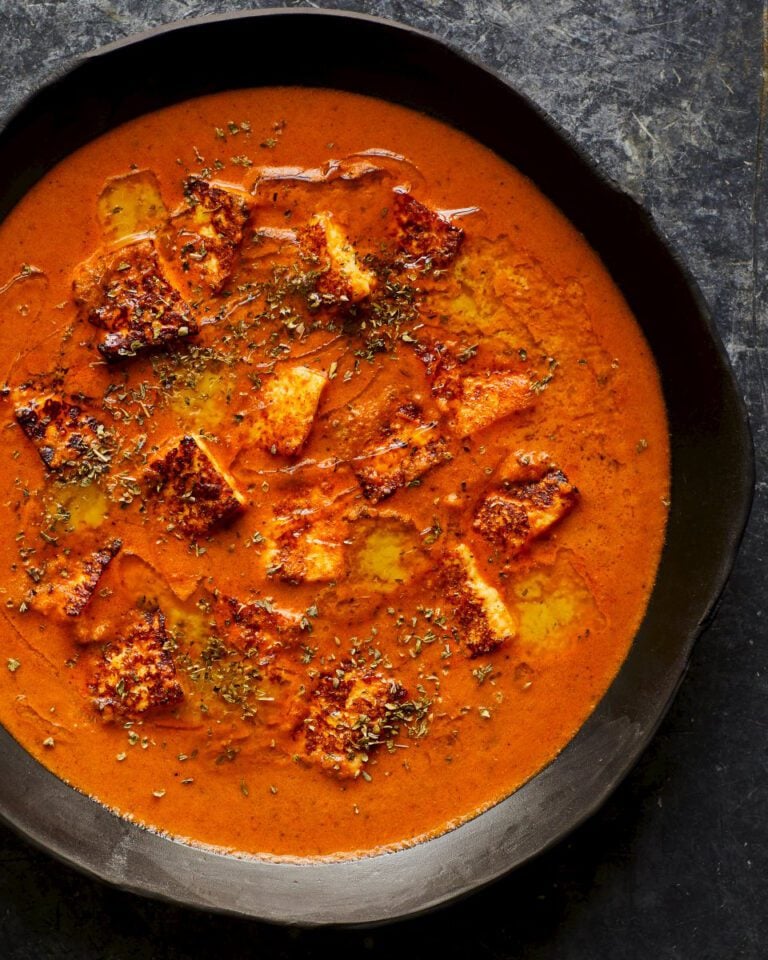
Aktar says: “Makhani is the inspiration behind the UK’s tikka masala, full of butter, cream and rich, warming spices. I’ve chosen paneer here as it’s easy to make at home but the sauce itself is so versatile – tandoori-marinated chicken is an obvious alternative. It has amazing aromatics running through it, and the honey adds sweetness to cut through the dairy. It’s a dish that’s become so popular, not just in northern India but across the entire subcontinent.”
Click here for Aktar’s easy Indo-Chinese vegan chilli recipe.
-
Serves 4
-
Hands-on time 25 min, plus overnight pressing (optional). Simmering time 40 min
Before you start
Making paneer at home is easy and very rewarding – but you can of course buy ready-made paneer if you prefer and skip straight to step 4 (you’ll need about 250g). Homemade paneer is a lot more delicate and porous than the processed stuff, however, so it absorb more of the flavour – it’s well worth giving it a go.
Ingredients
For the paneer
- 2 litres whole milk
- 50ml distilled vinegar
For the sauce
- 1 onion, sliced
- 5 large ripe tomatoes, sliced
- 2 tbsp cashew nuts, toasted
- 25g unsalted butter
- 2 dried cassia (Indian bay) leaves
- 3 cardamom pods
- 1 black cardamom pod
- 3 cloves
- ½ tsp black peppercorns
- 2cm piece cassia bark
- 2 tsp ginger-garlic paste
For the tempering
- 2 tbsp vegetable oil, plus a dash to fry the paneer
- 25g unsalted butter
- 1 tsp cumin seeds
- 1 green chilli, slit down the side
- 2cm piece ginger, chopped
- ¼ tsp ground turmeric
- 1 tsp kashmiri chilli powder
- ½ tsp ground coriander
- ¼ tsp garam masala
- 75ml double cream
- 1 tbsp runny honey
To serve
- 1 tsp kasoori methi, crushed (see Know How)
- 2 tbsp finely chopped coriander
- 25g unsalted butter, chopped (optional)
Specialist kit
- Muslin or cheesecloth (optional)
Method
- To make the paneer, pour the milk into a saucepan and bring to the boil. Once boiling, remove from the heat and stir in the vinegar. Keep stirring until the milk curdles – if it doesn’t curdle, put it back over a medium heat and add splashes of vinegar until it does.
- Line a large sieve with a large piece of muslin. Pour the curdled milk into the sieve to catch the solids, then rinse under running water to remove the vinegar. Tie the solids up in the muslin to form a ball, then give it a good squeeze to remove as much excess water as you can.
- Keeping the curds in the muslin, put it between 2 boards or trays and push down until there’s about a 2-3cm gap between them. Transfer to the fridge with a weight on top and leave overnight to set.
- The next day, make the sauce. Put all the sauce ingredients in a pan with 150ml water, then cover and put over a medium heat. Simmer for 20 minutes until the tomatoes have broken down and the cashew nuts are soft. Discard the cassia leaves (or bark), then transfer the mixture to a blender and whizz until smooth. Rinse out the pan, then strain the sauce back into it through a fine sieve to remove any remaining solids. Set aside.
- In a separate saucepan, prepare the tempering mixture. Add the oil and butter and put over a medium heat until foaming. Add the cumin seeds, chilli and ginger and cook for a minute, then add the ground spices. Cook for another minute, then pour in the set aside sauce. Simmer gently for 15 minutes until the oil separates.
- Meanwhile, cut your pressed paneer into roughly 2.5cm cubes – you want around 16-20. Add a dash of oil to a wide frying pan and fry the paneer for about 5 minutes, carefully turning regularly, until golden all over.
- Once the oil has separated from the sauce, add the cream, honey and a pinch of salt, tasting to see if it needs more salt or honey. Add the fried paneer and simmer for 5 minutes, then divide among bowls and top with the kasoori methi and coriander. Traditionally you’d also add small cubes of butter to stir through at the end.
- Recipe from April 2024 Issue
Nutrition
- Calories
- 560kcals
- Fat
- 46g (24g saturated)
- Protein
- 20g
- Carbohydrates
- 14g (13g sugars)
- Fibre
- 2.8g
- Salt
- 0.1g
delicious. tips
Cassia – or Indian bay – leaves are not like European bay leaves at all, so don’t be tempted to use them interchangeably. If you can’t find any, you can use a slightly larger piece of cassia bark instead. Kasoori methi are dried fenugreek leaves and add a subtle bitterness to many Indian dishes.
Buy ingredients online
Rate & review
Rate
Reviews
Subscribe to our magazine
Food stories, skills and tested recipes, straight to your door... Enjoy 5 issues for just £5 with our special introductory offer.
Subscribe
Unleash your inner chef
Looking for inspiration? Receive the latest recipes with our newsletter

